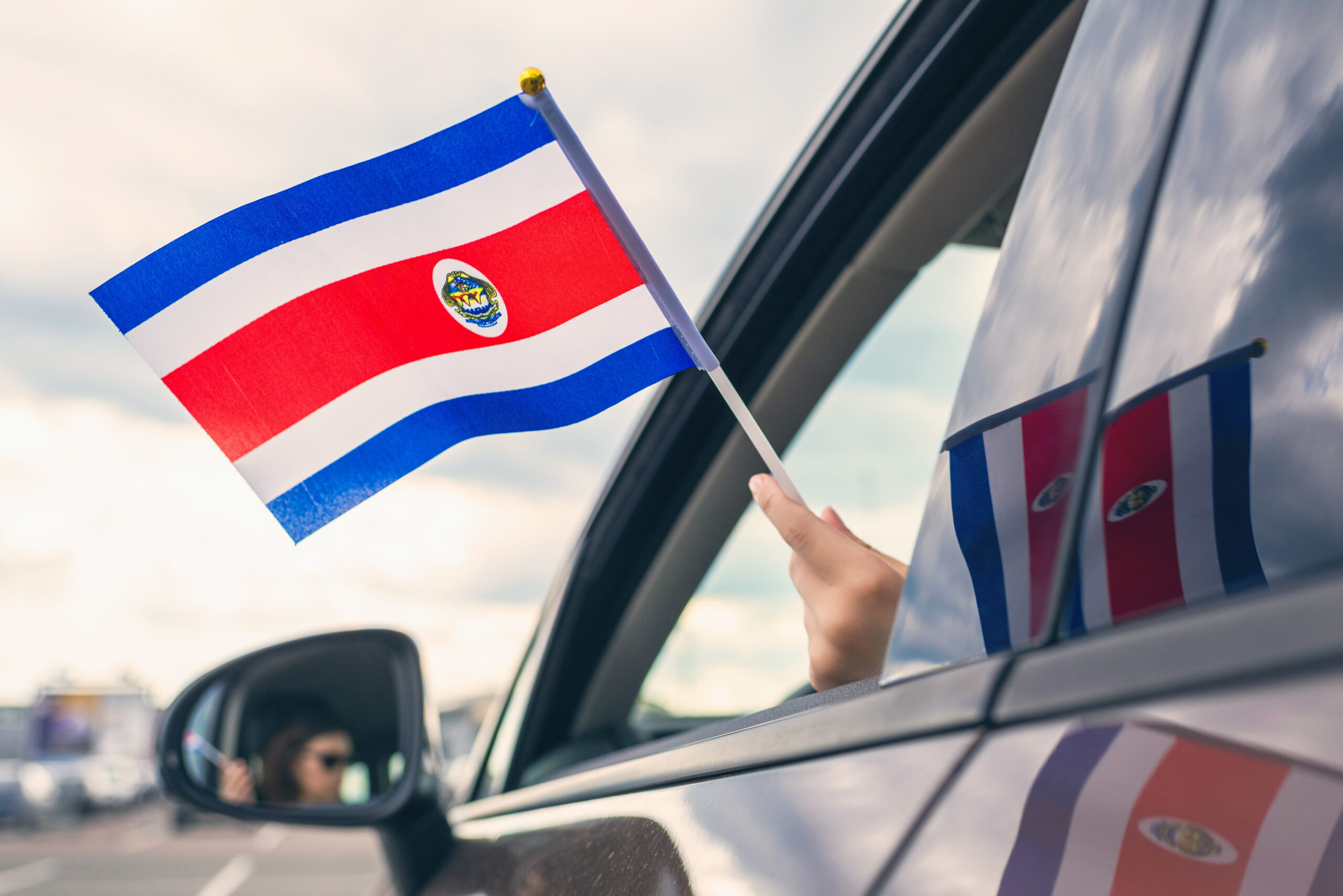Are you planning a road trip adventure through the stunning landscapes of Costa Rica? Before you hit the road, you should familiarize yourself with driving in this beautiful country.
Here are a few things you should know before you start driving around in Costa Rica:
- Driver’s License: A valid driver’s license from your home country is sufficient for driving in Costa Rica, as long as it is accompanied by a valid passport and it is stamped with your entry date into the country. As a foreigner you should always carry a photocopy of your passport photo page and the stamp page. If you have an International Driving Permit (IDP), this is also accepted. If you decide to get your Costa Rican Residency, then once you get your Cedula card you have 30 days to get a Costa Rican license.
- Insurance: It’s crucial to have the necessary insurance coverage when renting a car in Costa Rica. The mandatory insurance in Costa Rica is called “SOA” (Seguro Obligatorio de Automóviles) and is included in the rental price. However, this insurance only covers damages to third parties. Third-party liability coverage is priced at a daily fee ranging from $15 to $30 USD. The cost of other coverage types varies based on the type of vehicle rented. It is highly recommended to purchase additional insurance, such as Collision Damage Waiver (CDW), to protect yourself from potential damages to the rental vehicle. Sometimes your credit card from your originating country may covers the CDW so please check this out.
- Traffic Rules: It’s important to familiarize yourself with the local driving laws and regulations in Costa Rica. The speed limits in urban areas are typically 60 km/h (37 mph), while on highways, it can range from 80 km/h (50 mph) to 90 km/h (56 mph). It’s also worth noting that the use of seat belts is mandatory for both the driver and passengers and driving under the influence of alcohol or drugs is strictly prohibited. Costa Rican drivers have their own set of driving customs and etiquette. It’s common for drivers to use their horns as a form of communication, such as letting others know they are passing or warning of potential hazards. Additionally, be prepared for unexpected stops, such as when a driver decides to turn without signaling.
Renting a car in Costa Rica
Renting a car is the most convenient and flexible way to explore Costa Rica, allowing you to discover hidden gems off the beaten path and customize your itinerary to suit your preferences. There are several international car rental companies operating in Costa Rica, as well as local ones, offering a wide range of vehicles to choose from.
When renting a car in Costa Rica, it’s important to consider a few factors to ensure a smooth rental experience. Firstly, make sure to book your rental car in advance, especially during the peak travel season, as availability can be limited. It’s also recommended to compare prices and read customer reviews to find a reputable rental company that offers competitive rates and excellent customer service. Adobe is one of Costa Rica’s trusted rental vehicle providers.
Before signing the rental agreement, carefully review the terms and conditions, including the insurance coverage, fuel policy, and any additional fees or restrictions. It’s also advisable to inspect the vehicle thoroughly for any existing damages and take photos or videos as evidence to avoid any disputes upon returning the car.
Most rental cars in Costa Rica are manual transmission, so if you’re not comfortable driving a manual vehicle, make sure to request an automatic transmission in advance. Additionally, consider renting a vehicle with four-wheel drive (4WD) if you plan to venture into remote areas or explore the country during the rainy season when road conditions can be challenging.
Road conditions and driving safety in Costa Rica

Costa Rica’s roads offer a diverse range of conditions, from well-maintained highways to rugged dirt tracks, so it’s important to be prepared for varying road conditions and drive with caution. The main highways in Costa Rica, such as the Inter-American Highway (Route 1) and the Pan-American Highway (Route 2), are generally in good condition and well-marked, making them ideal for long-distance travel between major cities.
However, once you venture off the highways and into rural areas or national parks, you might encounter unpaved roads or potholes. It’s advisable to drive at a moderate speed and remain vigilant, especially during the rainy season when roads can become slippery and prone to flooding. In some remote areas, a high-clearance vehicle or four-wheel drive might be necessary to navigate rough terrain.
It’s also worth mentioning that Costa Rica has a unique road sign system, with many signs written in Spanish. Familiarize yourself with the common road signs and their meanings before your trip to ensure you can navigate them effectively. Additionally, be mindful of local driving habits and customs, such as yielding to the right and using your horn to signal your presence on blind corners. If you see a triangle this means you have to wait for the other side to come through first.
In terms of driving safety, it’s important to always wear your seat belt and ensure all passengers are buckled up. Avoid distractions while driving, such as using your phone or adjusting the radio, and maintain a safe following distance from other vehicles. If you’re unfamiliar with the area or unsure about directions, it’s best to pull over and consult a map or GPS device rather than trying to navigate while driving. Consider using Waze as it is among the top GPS apps for navigation. This is due to its popularity among Costa Ricans, who contribute real-time updates on traffic, accidents, construction, and other road conditions, making it a valuable tool for travelers.
Tips for navigating the Costa Rican roads

Navigating the roads of Costa Rica can be an adventure in itself, but with a few tips and tricks, you can make the most of your road trip and ensure a memorable journey. Here are some essential tips for navigating the roads of Costa Rica:
- Plan your itinerary: Before setting off on your road trip, plan your itinerary and research the best routes to reach your desired destinations. Take into account the driving distances, estimated travel times, and any attractions or viewpoints along the way that you don’t want to miss. Google Maps works in Costa Rica. We find WAZE a better map app to use. WAZE lets you know of any traffic or accidents and re-routes you accordingly.
- Embrace the Pura Vida lifestyle: Pura Vida, meaning “pure life,” is a popular phrase in Costa Rica that encapsulates the country’s laid-back and relaxed attitude. Embrace the Pura Vida lifestyle and allow for flexibility in your itinerary. Take your time to enjoy the stunning scenery, stop at roadside cafes for a delicious cup of Costa Rican coffee, and immerse yourself in the local culture.
- Be mindful of wildlife: Costa Rica is renowned for its incredible biodiversity, and you might encounter various wildlife while driving through national parks or rural areas. Be cautious of animals crossing the road, such as monkeys, sloths, or even deer. Slow down and give them plenty of space to ensure their safety and yours.
- Take breaks and stay hydrated: Costa Rica’s tropical climate can be hot and humid, especially in coastal areas. Take regular breaks to stretch your legs, hydrate, and reenergize. Costa Rica offers numerous scenic viewpoints, waterfalls, and beaches where you can take a refreshing break and soak in the natural beauty of the surroundings.
- Follow local recommendations: Locals often have the best knowledge of the area, so don’t hesitate to ask for recommendations on the best places to eat, scenic routes, or hidden gems that are off the tourist radar. Engaging with locals can not only enhance your road trip experience but also provide valuable insights into the culture and traditions of Costa Rica.
By following the essential tips and guidelines outlined in this guide, you can navigate the roads of Costa Rica with confidence. Whether you’re seeking adrenaline-pumping activities or simply yearning for a leisurely drive along scenic coastal routes, Costa Rica offers endless possibilities for exploration and discovery.
So, buckle up, set your GPS to adventure, and get ready to embrace the freedom of exploring Costa Rica by car. The enchanting roads await you, ready to lead you to the captivating wonders and hidden gems that make Costa Rica truly unique.
Ready to explore Costa Rica’s stunning landscapes and vibrant culture? Trust Flamingo Beach Realty to find your dream property amidst this tropical paradise. Contact us today to start your journey toward owning a piece of Costa Rica’s beauty.




